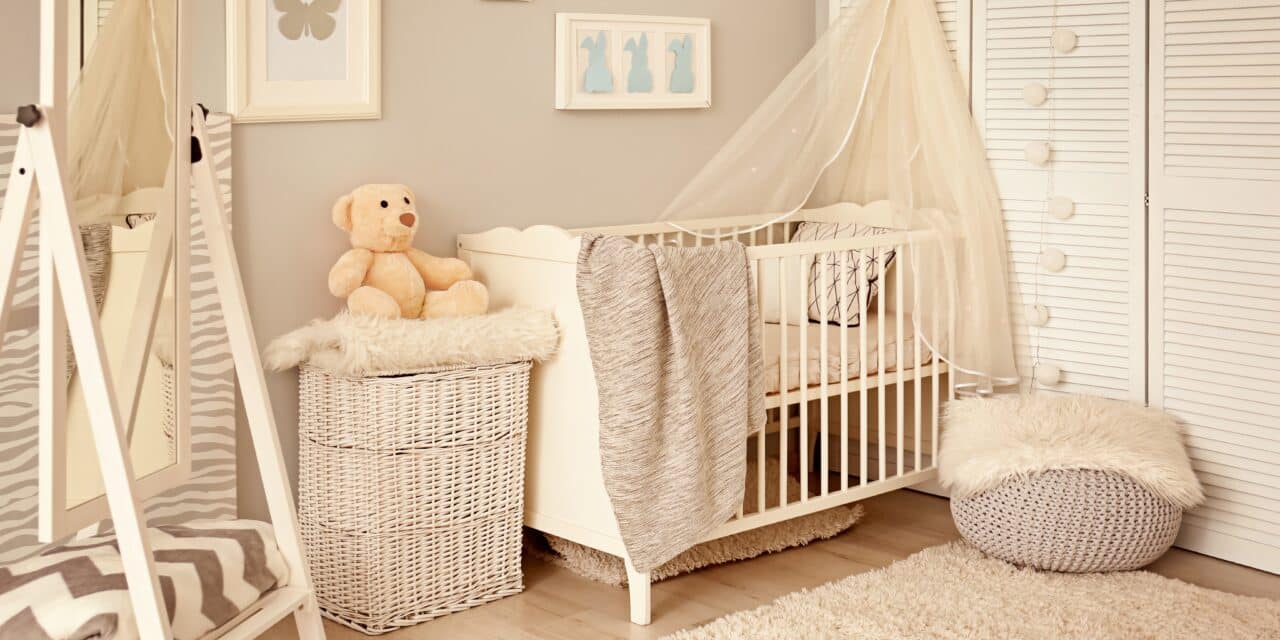When you paint a baby’s nursery, safety, indoor air quality, cleanability, and color comfort matter just as much as style. Below, we use pro know‑how to answer every question you might have—from VOCs and finishes to timelines, cleaning, older-home hazards, furniture, and more—so you can create a healthy, soothing room that holds up to real family life.
👶 Basics & Safety
Q: What type of paint is best for a nursery?
Choose water‑based, zero‑VOC, low‑odor interior wall paint in a durable, washable finish (eggshell or satin). This combination balances indoor air quality, cleanability, and a soft look.
Q: Which paint is “safest” for babies?
Look for “zero‑VOC,” “low odor,” and certifications like GREENGUARD Gold or “asthma & allergy friendly®.” Product datasheets (SDS/TDS) should explicitly say “zero VOC” after tint.
Q: Where can I get safer paints?
Shop category pages so you always see current formulas: [Shop zero‑VOC interior wall paints at Lowe’s]. Early pick for trim/furniture durability: [Shop low‑VOC interior enamel/semi‑gloss].
Pro note: Category links stay valid even if brands or SKUs change.
Q: Are VOCs and “paint smell” the same?
Related, not identical. VOCs are chemicals that off‑gas; odor is the smell you notice. You want both low‑VOC and low‑odor.
Q: Is oil‑based paint okay in a nursery?
Avoid it. Oil‑based paints have stronger solvents, longer cure times, and more odor. Use modern acrylic/latex systems instead.
Q: How long after painting can baby sleep in the room?
With zero‑/low‑VOC paint, allow ~2 weeks of ventilation for full cure and odor dissipation (longer if humidity is high).
Q: Can I paint while pregnant?
Best to delegate. Even low‑VOC paints need ventilation and proper PPE. If you must participate, use gloves, a mask, and take frequent fresh‑air breaks.
🛡️ Indoor Air Quality (IAQ) & Health
Q: What else affects IAQ besides paint?
Primers, caulks, spackles, and cleaners. Choose low‑VOC versions across the board and ventilate. Consider MERV‑13 HVAC filters during/after painting.
Q: Do “air‑purifying” or “microbicidal” paints help?
They can reduce odors/microbes on the film, but they’re not a replacement for ventilation, cleaning, or humidity control. Treat claims as add‑ons, not magic.
Q: Any special ventilation tips?
Create a cross‑breeze (two open windows/doors), use a box fan exhausting outside, and keep airflow going for several days.
🎯 Finishes, Surfaces & Where to Use Them
Q: Best finish for nursery walls?
Eggshell for a soft look with wipeability. Satin where you expect more mess (near doors, play areas).
Q: What about ceilings?
Use flat/matte on ceilings to hide seams/texture and reduce glare over the crib.
Q: Trim, doors, and baseboards?
Use semi‑gloss (tough, wipeable, crisp). If you prefer subtler, satin works too.
Q: Built‑ins and wainscoting?
Satin or semi‑gloss—they’ll withstand bumps and cleaning better than eggshell.
Q: Bathroom inside a nursery suite?
Go satin or semi‑gloss with a mildew‑resistant interior formula and excellent ventilation.
Q: Accent walls or murals—what sheen?
Keep accents eggshell (or satin only if walls are very smooth). Glossier sheens will highlight roller/brush marks and wall flaws.
🌈 Colors, Lighting & Mood
Q: What colors help babies rest?
Soft, muted cools (pale blues/sages), warm neutrals (cream, oatmeal, light beige), or gentle lavender can be calming.
Q: Are bright colors bad?
Not “bad,” but intense reds/oranges can be stimulating. Use brights as accents, not full walls.
Q: Should I paint the ceiling a color?
Yes—try a softer tint of your wall color or pale sky‑blue. Babies look up often; a calming ceiling helps.
Q: What is LRV and why care?
Light Reflectance Value (0–100). Higher LRV = lighter/brighter. In small nurseries, higher LRV walls reflect more light and feel airier.
Q: Will color look different at night?
Yes. Always test large samples on multiple walls; check in daylight and lamplight.
🧰 Prep, Materials & Compatibility
Q: Do I need primer?
Usually, yes. Use stain‑blocking primer on patched areas or when covering dark colors. Over glossy paint, scuff‑sand + prime for adhesion.
Q: Can I paint over old oil‑based paint?
Yes—degloss (scuff‑sand or liquid sandpaper), then bonding primer, then topcoat.
Q: Patching compounds or caulk tips?
Choose low‑odor spackle and paintable, low‑VOC caulk (like acrylic‑latex). Tool joints with a damp finger, let dry fully, then prime.
Q: Tools—what roller/brush?
Use a ⅜” nap roller for smooth walls (½” for light texture), and quality nylon/polyester brushes for crisp trim lines.
🖌️ Application & Timeline
Q: How many coats?
Typically 2 coats after spot‑priming/priming.
Q: Roll, spray, or both?
For most nurseries, roll + brush is cleanest and best for IAQ (less overspray). Spray can be fine with masking and ventilation.
Q: Ideal painting weather?
Aim for 40–60% RH (relative humidity), 60–80°F. In cold Northeast Ohio winters, ventilate but avoid freezing air onto fresh paint.
Q: Timeline to be “move‑in ready”?
Day 0–1: Prime & paint.
Day 2–3: Light odor remains; keep ventilating.
Day 4–14: Paint cures; wait ~2 weeks before full nursery setup/sleep.
🧼 Cleaning, Touch‑Ups & Longevity
Q: How do I clean nursery walls?
Use mild soap + soft sponge. Avoid harsh chemicals and scrub pads that burnish paint.
Q: Magic Eraser—yes or no?
Use sparingly; it’s micro‑abrasive and can leave dull spots.
Q: How long should the finish last?
Quality acrylic eggshell/satin can look great 5–10 years with normal cleaning.
Q: Best way to touch up?
Keep labeled leftovers. For eggshell/satin, feather edges; if you see flashing, repaint the full wall.
🪑 Furniture, Cribs & Floors
Q: Can I use wall paint on cribs or dressers?
Use furniture‑rated enamels (water‑based) and allow full cure per label before use. Add crib rail guards so a teething baby doesn’t ingest finish.
Q: Is gloss okay on furniture?
Yes—semi‑gloss/gloss are durable and wipeable on furniture/trim.
Q: Floors or rugs first?
Paint before flooring installs or protect floors with heavy rosin paper and taped seams.
Q: Safe finishes for a DIY crib?
Choose water‑based, zero‑VOC clear coats once fully cured; still use rail protectors.
🏚️ Special Situations (Older Homes, Mold, Smoke)
Q: Pre‑1978 home—lead risks?
Assume lead may be present. Don’t dry‑sand unknown layers. Use EPA lead test kits and hire EPA RRP‑certified pros for disturbing old coatings.
Q: Mold or musty odors?
Fix moisture sources first (leaks, humidity). Treat/encapsulate stains with stain‑blocking primer, then topcoat with a mildew‑resistant interior paint.
Q: Smoke or pet odors in the nursery?
Use odor‑sealing primers designed for smoke/pet smells before painting.
💸 Budget, DIY vs. Pro & Scheduling
Q: Should I DIY or hire a pro?
DIY is fine if you’re comfortable with prep, cutting lines, and masking. Hire a pro for lead concerns, heavy patching, cabinet enameling, or tight timelines.
Q: How much paint will I need?
A typical 10’×12′ room with 8′ ceilings needs ~2 gallons for two coats (walls), plus 1 quart for trim—adjust for windows/doors and texture.
Q: Any hidden costs to plan for?
Primers, caulk, patching supplies, PPE, rollers/brushes, plastic/rosin paper, and extra cleaning supplies.
🌱 Eco, Disposal & Leftovers
Q: What do I do with leftover paint?
Keep a clearly labeled quart for touch‑ups (brand, color, formula, sheen, date, room). Store away from freezing temps.
Q: Can I pour rinse water down the drain?
Don’t. Let wash water settle, strain out solids, and follow local disposal guidance.
Q: What about recycling paint?
Check local household hazardous waste events; many accept latex for responsible disposal.
🧩 Extras Parents Ask All the Time
Q: Do I need a special nursery primer?
No, but choose low‑odor/low‑VOC and the right type (stain‑blocker for marks, bonding for glossy surfaces).
Q: What about chalkboard/whiteboard paint in a nursery?
Fun for later years; keep it to one accent zone and choose low‑VOC formulas.
Q: Are peel‑and‑stick wallpapers safer than paint?
They can be, but check adhesive VOCs and off‑gassing. Paint is often easier to wipe clean long‑term.
Q: Night‑light and bulb color?
Use 2700–3000K warm bulbs in lamps/sconces; cooler light feels alerting.

